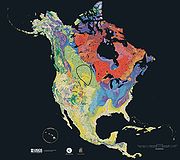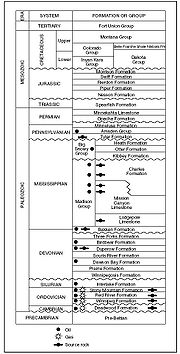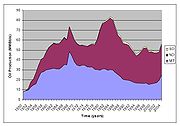
Williston Basin
Encyclopedia

Montana
Montana is a state in the Western United States. The western third of Montana contains numerous mountain ranges. Smaller, "island ranges" are found in the central third of the state, for a total of 77 named ranges of the Rocky Mountains. This geographical fact is reflected in the state's name,...
, western North
North Dakota
North Dakota is a state located in the Midwestern region of the United States of America, along the Canadian border. The state is bordered by Canada to the north, Minnesota to the east, South Dakota to the south and Montana to the west. North Dakota is the 19th-largest state by area in the U.S....
and South Dakota
South Dakota
South Dakota is a state located in the Midwestern region of the United States. It is named after the Lakota and Dakota Sioux American Indian tribes. Once a part of Dakota Territory, South Dakota became a state on November 2, 1889. The state has an area of and an estimated population of just over...
, and southern Saskatchewan
Saskatchewan
Saskatchewan is a prairie province in Canada, which has an area of . Saskatchewan is bordered on the west by Alberta, on the north by the Northwest Territories, on the east by Manitoba, and on the south by the U.S. states of Montana and North Dakota....
known for its rich deposits of petroleum
Petroleum
Petroleum or crude oil is a naturally occurring, flammable liquid consisting of a complex mixture of hydrocarbons of various molecular weights and other liquid organic compounds, that are found in geologic formations beneath the Earth's surface. Petroleum is recovered mostly through oil drilling...
and potash
Potash
Potash is the common name for various mined and manufactured salts that contain potassium in water-soluble form. In some rare cases, potash can be formed with traces of organic materials such as plant remains, and this was the major historical source for it before the industrial era...
. The basin is a geologic structural basin but not a topographic depression; it is transected by the Missouri River
Missouri River
The Missouri River flows through the central United States, and is a tributary of the Mississippi River. It is the longest river in North America and drains the third largest area, though only the thirteenth largest by discharge. The Missouri's watershed encompasses most of the American Great...
. The oval-shaped depression extends approximately 475 miles (764.4 km) north-south and 300 miles (482.8 km) east-west.
The Williston Basin lies above an ancient Precambrian
Precambrian
The Precambrian is the name which describes the large span of time in Earth's history before the current Phanerozoic Eon, and is a Supereon divided into several eons of the geologic time scale...
geologic basement
Basement Rock
Basement or Basement Rock music was a sub-genre coined in 2006 in an article by music magazine TGR. This was first in relation to the existence of underground record label Criminal Records but more for the independent bands they represent. The roots of the sub-genre are noted to be as far back as...
feature, the Trans-Hudson Orogenic Belt
Trans-Hudson orogeny
The Trans-Hudson orogeny, Trans-Hudsonian orogeny, Trans-Hudson orogen , or Trans-Hudson Orogen Transect , , was the major mountain building event that formed the Precambrian Canadian Shield, the North American craton , and the...
that developed in this area about 1.8-1.9 billion years ago, and that created a weak zone that later led to sagging to produce the basin. The Precambrian basement rocks in the center of the basin beneath the city of Williston, North Dakota
Williston, North Dakota
-Demographics:Preliminary data from a 2010 housing study indicates that population has grown by nearly 22 percent over the past decade; the actual increase might be much higher. Williston is in western North Dakota's booming oil patch, and adequate, affordable housing has become a concern. The...
lie about 16000 feet (4,876.8 m) below the surface.

Cambrian
The Cambrian is the first geological period of the Paleozoic Era, lasting from Mya ; it is succeeded by the Ordovician. Its subdivisions, and indeed its base, are somewhat in flux. The period was established by Adam Sedgwick, who named it after Cambria, the Latin name for Wales, where Britain's...
time, but subsidence and basin filling were most intense during the Ordovician
Ordovician
The Ordovician is a geologic period and system, the second of six of the Paleozoic Era, and covers the time between 488.3±1.7 to 443.7±1.5 million years ago . It follows the Cambrian Period and is followed by the Silurian Period...
, Silurian
Silurian
The Silurian is a geologic period and system that extends from the end of the Ordovician Period, about 443.7 ± 1.5 Mya , to the beginning of the Devonian Period, about 416.0 ± 2.8 Mya . As with other geologic periods, the rock beds that define the period's start and end are well identified, but the...
, and Devonian
Devonian
The Devonian is a geologic period and system of the Paleozoic Era spanning from the end of the Silurian Period, about 416.0 ± 2.8 Mya , to the beginning of the Carboniferous Period, about 359.2 ± 2.5 Mya...
Periods, when thick accumulations of limestone and dolomite, with lesser thicknesses of sandstones, siltsones, shales, and evaporites were laid down. Subsidence continued on a reduced scale into the Mississippian and was largely ended by Pennsylvanian
Pennsylvanian
The Pennsylvanian is, in the ICS geologic timescale, the younger of two subperiods of the Carboniferous Period. It lasted from roughly . As with most other geochronologic units, the rock beds that define the Pennsylvanian are well identified, but the exact date of the start and end are uncertain...
time. Regional subsidence returned during the Mesozoic
Mesozoic
The Mesozoic era is an interval of geological time from about 250 million years ago to about 65 million years ago. It is often referred to as the age of reptiles because reptiles, namely dinosaurs, were the dominant terrestrial and marine vertebrates of the time...
Era, although total sediment thicknesses were much less than during the Paleozoic
Paleozoic
The Paleozoic era is the earliest of three geologic eras of the Phanerozoic eon, spanning from roughly...
. Near the end of the Cretaceous
Cretaceous
The Cretaceous , derived from the Latin "creta" , usually abbreviated K for its German translation Kreide , is a geologic period and system from circa to million years ago. In the geologic timescale, the Cretaceous follows the Jurassic period and is followed by the Paleogene period of the...
, tectonic activity during the Laramide Orogeny
Laramide orogeny
The Laramide orogeny was a period of mountain building in western North America, which started in the Late Cretaceous, 70 to 80 million years ago, and ended 35 to 55 million years ago. The exact duration and ages of beginning and end of the orogeny are in dispute, as is the cause. The Laramide...
rejuvenated several basement structures in the Williston Basin to produce anticlines that serve as oil traps today.
Petroleum

Source rock
In petroleum geology, source rock refers to rocks from which hydrocarbons have been generated or are capable of being generated. They form one of the necessary elements of a working petroleum system. They are organic-rich sediments that may have been deposited in a variety of environments including...
and reservoir rocks
Petroleum geology
Petroleum geology refers to the specific set of geological disciplines that are applied to the search for hydrocarbons .-Sedimentary basin analysis:...
. The basin's oil and gas fields are found in a wide range of geologic ages, as indicated by the generalized stratigraphic column.
Oil was first found in the Williston Basin along the Cedar Creek Anticline in southeastern Montana, in the 1920s and 1930s. The basin did not become a major oil province until the 1950s when large fields were discovered in North Dakota. Production peaked in 1986, but in the early 2000s significant increases in production began because of application of horizontal drilling techniques, especially in the Bakken Formation
Bakken Formation
The Bakken formation, initially described by geologist J.W. Nordquist in 1953,is a rock unit from the Late Devonian to Early Mississippian age occupying about of the subsurface of the Williston Basin, underlying parts of Montana, North Dakota, and Saskatchewan...
.
Cumulative basin production totals about 3.8 Goilbbl of oil and 470 Gcuft of natural gas. The largest oil fields are listed in the following table, showing estimated ultimate recoveries.
| Field Name | Discovery Year | Est. ult. oil (million barrels) |
Est. ult. gas (billion cubic feet) |
Est. ult. nat. gas liquids (million barrels) |
|---|---|---|---|---|
| Elm Coulee Elm Coulee Oil Field Elm Coulee Oil Field was discovered in the Williston Basin in Richland County, eastern Montana, in 2000. It produces oil from the Bakken Formation and, as of 2007, is the "highest-producing onshore field found in the lower 48 states in the past 56 years." By 2007, the field had become one... , Richland Co.,MT |
2000 | 270 | ||
| Beaver Lodge, N. Dak. | 1951 | 130 | 115 | 47 |
| Pine, Mont. | 1952 | 127 | 20 | |
| Pennel, Mont. | 1955 | 115 | ||
| Cabin Creek, Mont. | 1953 | 115 | ||
| Little Knife, N. Dak. | 1977 | 96 | 120 | 15 |
| Tioga, N. Dak. | 1952 | 77 | 43 | 17 |
| Blue Buttes, N. Dak. | 1955 | 53 | 36 | 5 |
| Charlson, N. Dak. | 1952 | 52 | 100 | 11 |
Potash
PotashPotash
Potash is the common name for various mined and manufactured salts that contain potassium in water-soluble form. In some rare cases, potash can be formed with traces of organic materials such as plant remains, and this was the major historical source for it before the industrial era...
produced from the Williston Basin makes Canada the world's leading producer of that commodity. Major potash-producing companies include the Potash Corporation of Saskatchewan
Potash Corporation of Saskatchewan
The Potash Corporation of Saskatchewan Inc. , also referred to as PotashCorp, is a Canadian corporation based in Saskatoon, Saskatchewan. The company is the world's largest potash producer and the third largest producers of nitrogen and phosphate, three primary crop nutrients used to produce...
.
Coal
The Williston Basin holds large coal deposits, primarily in the Fort Union FormationFort Union Formation
The Fort Union Formation is a geologic unit containing sandstones, shales, and coal beds in Wyoming, Montana, and parts of adjacent states. In the Powder River Basin, it contains important economic deposits of coal, uranium, and coalbed methane....
of mostly Paleogene
Paleogene
The Paleogene is a geologic period and system that began 65.5 ± 0.3 and ended 23.03 ± 0.05 million years ago and comprises the first part of the Cenozoic Era...
age.

